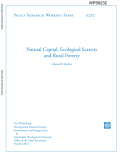The world is increasingly faced with the challenges stemming from the need to sustain an expanding global population while simultaneously addressing the environmental pressures that could threaten our ability to accomplish this. Green growth has emerged as a strategy to balance the historically divergent priorities of achieving economic growth and social development without putting at risk the environmental systems and natural capital we rely so heavily upon. This approach emphasizes the environmental and economic gains achieved by reducing inefficiencies in the management of resources and the stimulation of new sources of activity through innovation and green market growth.
IISD and the Partnership for Procurement and Green Growth conducted an investigation to explore the correlation between public procurement and the tipping point at which it serves as a trigger for green industrial innovation, expansion and growth. Building on the existing body of work that supports the case for green public procurement, the report demonstrates that procurement is becoming more than just a purchasing tool, but is increasingly positioned as an economic driver, an incentive for green innovation and green industrialisation, a support for small and medium enterprise (SME) competitiveness and much more.
Environmental information transparency performs social and learning functions indispensable for green growth. Still facing the challenges of a lack of local commitment and less than optimal institutional capacity, China has made substantial progress on granting and enforcing the public right to environmental information. This will help build the social infrastructure necessary for green growth — the rule of law, trust, social organizing, consensus building, social learning, and collective action. A focused approach is desirable because resources and capacity are limited in China — targeting pollutants and sectors that exert the most environmental and health risks as well as those that need technological upgrade most urgently. Then, in the long run, environmental information transparency serves the fundamental goals of ‘good public policy and legitimate governmental decision-making’ on environment-related issues in China, in line with both the green growth framework and the long-term development goal of constructing a harmonious society in China.
The developing world is experiencing substantial environmental change, and climate change is likely to accelerate these processes in the coming decades. Due to their relatively high dependence on environmental capital for their livelihoods, and to their limited resources for mitigation and investment in adaptation, the poor are likely to suffer most. Economic growth is essential for any large-scale poverty reduction.

Much of the rural poor -- who are growing in number -- are concentrated in ecologically fragile and remote areas. The key ecological scarcity problem facing such poor households is a vicious cycle of declining livelihoods, increased ecological degradation and loss of resource commons, and declining ecosystem services on which the poor depend. In addition, developing economies with high concentrations of their populations on fragile lands and in remote areas not only display high rates of rural poverty, but also are some of the poorest countries in the world today. Policies to eradicate poverty therefore need to be targeted at the poor where they live, especially the rural poor clustered in fragile environments and remote areas.
